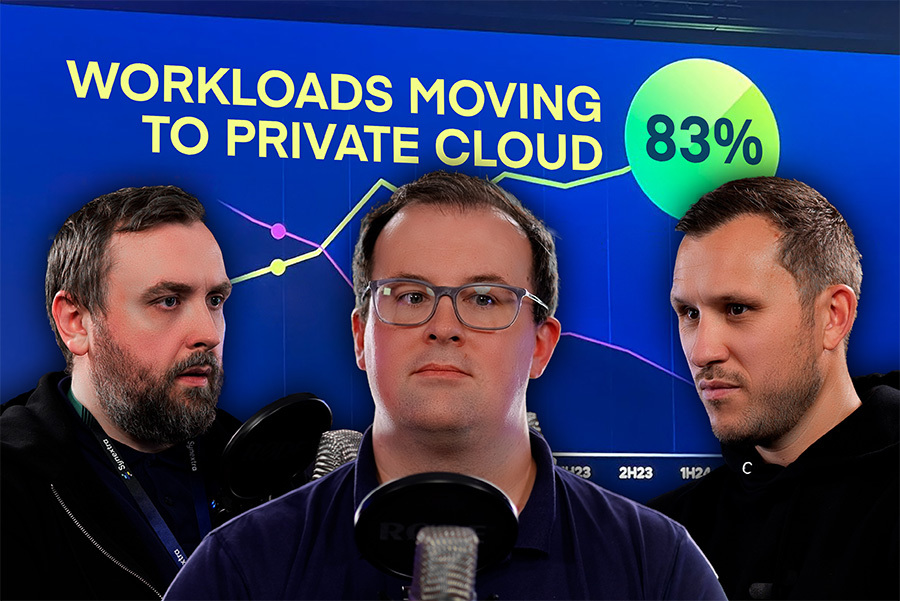When you dig a little deeper, it’s clear that the number probably isn’t telling the whole story. While it’s true that some workloads are returning to private cloud, cloud spending is still on the rise across the board. What’s happening is more nuanced: many organisations are finding that certain workloads, particularly those with specific performance or security needs, might be better suited for on-prem, but the majority of businesses are still increasing their overall cloud spend.
As Ryan, Head of Technical Operations at Synextra, points out, “If you take that single stat out of context, it might seem like cloud is over and everyone’s going back to on-prem. But the reality is, these same CIOs are saying that their cloud spend is going up too.”
It seems that in reality, businesses are still trying to find the right balance between cloud and on-prem infrastructure. It’s not that they’re abandoning the cloud altogether, but rather making strategic decisions about where certain workloads are best hosted.
Why are some workloads coming back to private cloud?
While it’s true that some workloads are returning to on-prem or private cloud environments, it’s not always because the cloud has failed them. Often, companies are finding that certain workloads, like large databases or apps that need very high throughput, might be more cost-effective or performant on-prem.
As Matt, one of our technical consultants, explains: “It could just be a single workload they tried to move to the cloud that isn’t working well for them—whether it’s due to cost or performance—so they’re bringing it back down to on-prem.”
For enterprise businesses, where database tech is expensive, the cloud can rack up significant costs, especially when optimising for performance isn’t always possible. Workloads that need 24/7 availability, heavy processing power, or large databases sometimes just make more sense on-prem, where existing resources can be reused.
What does this mean for SMBs in the Cloud?
While enterprises might be leading the charge on cloud repatriation, small to medium-sized businesses (SMBs) are unlikely to bring back entire infrastructures from the cloud. Instead, hybrid solutions are becoming more popular, where specific workloads return to on-prem for cost savings, while the bulk of operations remain in the cloud.
For many SMBs, the flexibility of Azure’s cloud services means they can access technology they wouldn’t otherwise afford to build or maintain on-prem. Even if it’s just a storage workload or one small application, it can be a strategic choice for SMBs looking to save money. But full repatriation? Probably not – they still need the cloud’s flexibility and disaster recovery capabilities, for example.
Security concerns and cloud vs. on-prem
One of the primary reasons cited for moving workloads back on-prem is security. Some organisations worry that the cloud might not offer the same level of control they’re used to in on-prem environments. But the reality is that cloud security has evolved to meet – and often exceed – the protections that can be put in place on-prem.
As Ryan mentions: “It’s not that there’s anything you can’t do on-prem that you can in the cloud. But how much would you need to spend to build that solution on-prem? In Azure, you’ve got those protections built-in, and the cost of maintaining them is spread out.”
For SMBs, cloud services like Azure Defender provide enterprise-level security that wouldn’t be affordable to build from scratch. Moving back to on-prem might actually create more security gaps if the right investments aren’t made. The advantages lie in gaining access to the cloud platform’s built-in security features and making sure best practices are followed.
AI and privacy concerns: Is it driving cloud repatriation?
Some argue that privacy and AI concerns are pushing businesses to move workloads back on-prem, but the reality is a bit more complex. Many large organisations see AI growth as a key driver of increased cloud spending, not repatriation. The fear that cloud-based AI tools will scoop up sensitive data doesn’t seem to resonate with CIOs at the enterprise level.
These enterprises are investing heavily in AI within the cloud. They know the risks and benefits, and they’re choosing to continue their digital transformation. So, while privacy concerns may arise, they’re not a significant factor in repatriation for most companies.
Latency, performance, and hybrid cloud
Latency is often cited as a reason for bringing workloads back on-prem, especially for specific applications like databases that require sub-millisecond performance. However, hybrid cloud solutions offer the best of both worlds—allowing businesses to keep latency-sensitive workloads on-prem while utilising the scalability and flexibility of the cloud for everything else.
Ryan explains: “We’ve seen cases where businesses needed super low-latency environments, but Azure can still accommodate that by setting up the right infrastructure, like ExpressRoute, to reduce latency issues.”
While Azure is more friendly towards latency-sensitive apps than people might expect, hybrid solutions are particularly appealing to businesses that need that cloud agility without compromising on performance.
Cloud Vendor lock-in: Is it a real concern?
A common concern when discussing cloud strategy is vendor lock-in—the fear that once you’ve invested in a cloud provider, it becomes difficult (and expensive) to move away. But the reality is, with so many competitive cloud providers out there, businesses have more flexibility than ever before. Whether it’s AWS, Azure, or GCP, each provider offers migration tools and multi-cloud options to ease these transitions.
Chris, our CEO, explains: “The market is too competitive for any one vendor to truly lock you in. As long as there are alternatives like AWS and Google, businesses can switch, if necessary, without too much hassle.”
The real challenge is optimising your cloud strategy from the outset, ensuring your workloads are set up in the most efficient, cost-effective way possible. If you’re mindful of best practices and planning for future flexibility, vendor lock-in becomes less of a worry.
So, is it really happening? Is everyone going back to on-prem?
Nope. In reality, cloud repatriation isn’t as dramatic as the headlines suggest. Yes, some workloads may move back on-prem, but cloud spending continues to grow, and businesses are embracing the flexibility of hybrid cloud solutions.
As Chris notes during our conversation: “83% of people might bring something back on-prem, but it’s not 83% of their workloads—context is everything.”
For most organisations, especially small to mid-sized ones, the cloud remains a cost-effective and secure way to scale operations. We think the cloud still offers immense value, and smart businesses from various industry sectors will continue to move to cloud platforms.
We recommend checking out the podcast if you’d like a deeper understanding of what’s really going on.
Read the Barclays CIO Survey
Looking to change things up in your IT infrastructure? Moving onto the cloud, off of it, or across platforms – whatever you’re interested in, why not talk to Synextra? We’re a boutique cloud MSP that does things a bit differently. Contact us and we’ll be happy to help.




